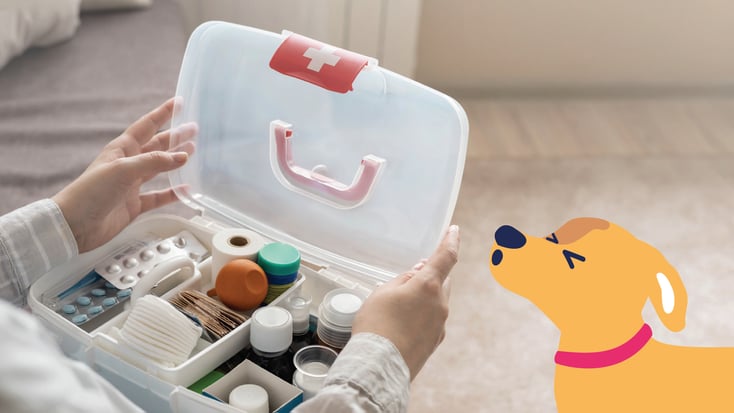Pet First Aid Kit Essentials: What Should You Have?

Do you have a first aid kit in your home for cuts, scrapes, and minor emergencies? As a pet parent, it's important to ensure you're equally as prepared for your pet. Every pet parent should have a pet first aid kit on-hand, equipped with basic supplies in the event of a mild injury or accident.
In the event of an accident, having a pet first aid kit gives you easy access to everything you need to address your pet's injury in a time of crisis. Ready to start putting together a pet first aid kit for your home? Below, explore this guide that covers everything you should include in your pet's first aid kit.
What Should You Have in Your Pet First Aid Kit?
As you start to compile items for your pet's first aid kit, start with the essentials. These basic items can come in handy in several different scenarios. Your kit should contain:
- Absorbent gauze pads
- Adhesive tape
- Cotton balls or swabs
- Ice pack/heat pack
- Tweezers
- Scissors with blunt end
- Disposable gloves
- Antibiotic ointment
- Bandages
- Digital thermometer
- Hydrogen peroxide
- Documentation/paperwork
When considering what should be in a pet first aid kit, it's also important to consider your pet's specific needs. Is your pet prone to a certain type of injury? Does your pet have a medical condition that may require special medications? You know your pet best! In addition to the staples, consider your pet's individual needs, too.
Have children in your home? Be sure to keep your pet's first aid kit in a place that is easy to reach for adults but out of harm's way for kids in the household. All adults in the home should be informed of where the pet first aid kit is located.
Are You a Pet Safety Expert?
1. Which one of the plants below is toxic to cats if ingested?
2. Which of the foods below is generally considered safe for your dog to eat?
3. Above what temperature is too hot to leave a pet in your car?
4. Which kind of leash is the safest to walk your dog?
5. True or False: If a medication is safe for humans, it is probably safe for pets.
6. What should you do if you think your pet ate something toxic?
View Results
Are You a Pet Safety Expert?
1. Which one of the plants below is toxic to cats if ingested?
2. Which of the foods below is generally considered safe for your dog to eat?
3. Above what temperature is too hot to leave a pet in your car?
4. Which kind of leash is the safest to walk your dog?
5. True or False: If a medication is safe for humans, it is probably safe for pets.
6. What should you do if you think your pet ate something toxic?
Share Quiz
Purpose of Items in a Pet First Aid Kit
Knowing what to put in your pet's first aid kit is only half the battle! It's important to understand the purpose of each item in the pet first aid kit and how to use it when needed. Furthermore, if you use items in your first aid kit, it's important to remember to restock supplies for the next use.
Ice/Heat Packs
In the event of an injury, having an ice and/or heat pack nearby can help make your pet more comfortable. Cold compress therapy can be used to reduce swelling and inflammation associated with muscle injuries your pet may have. Hot packs can help to increase blood flow to a specific injury. A general rule of thumb is to begin with cold therapy and transition to heat therapy if the issue persists.
Tweezers
Having a pair of tweezers in your pet's first aid kit can be helpful if you need to remove a sharp object from your pet's skin. It can also be helpful in tick removal. Removing a tick promptly from your pet is important to help prevent common tick diseases in pets.
Antibiotic Ointment
Every pet first aid kit should include an over-the-counter antibiotic ointment. This will come in handy for superficial wounds. Most over-the-counter antibiotic ointments used for humans are also safe for pets. However, you may wish to confirm with your BetterVet veterinary doctor during your next pet wellness exam.
Your BetterVet veterinary doctor may suggest a pet-friendly, fast-acting ointment for your first aid kit. This ointment can be used on cuts, rashes, sores, or other minor injuries. Remember, antibiotic ointment should never be used near your pet's eyes.
Documentation/Paperwork
If your dog is on medications or suffers from a medical condition, you may wish to keep detailed documents in the pet first aid kit. In the event of an emergency, it can be helpful to have all the information you need right at your fingertips. This includes medication lists, pet vaccination records, and other pet medical info you may have available.
Frequently Asked Questions
What is in a pet first aid kit?
Most pet first aid kits include general essential items that can be useful in a wide variety of minor illnesses. As you pack your pet's first aid kit, it may be helpful to consult the American Veterinary Medical Association's pet first aid kit checklist. While some items in a human first aid kit can be helpful for pets, it's best to have a pet-friendly first aid kit available.
Will my pet's first aid kit be enough to help my pet?
A pet first aid kit is only to address minor, non-emergent medical concerns such as minor scratches or injuries. If your pet is experiencing ongoing symptoms, schedule an in-home sick pet visit with BetterVet promptly. If your pet is experiencing serious, life-threatening symptoms, seek medical attention immediately from the nearest emergency veterinary hospital.
What contact info should be included in my pet's first aid kit?
If your pet suffers from an injury or illness, you'll want to have contact information readily available in their pet first aid kit. Same-day or next-day in-home visits can be scheduled right from BetterVet's online appointment portal.
It can also be helpful to have contact information handy for the nearest emergency veterinary hospital or clinic and for animal poison control. Some pet parents keep these numbers handy on a notecard in their pet first aid kit or saved in their cell phone contacts for easy access.
Ask Your BetterVet Veterinary Doctor For Help
Have questions about putting together a complete first aid kit? This pet first aid kit list is just a guideline to help you get started. If your dog has a specific medical condition, your pet's first aid kit might need to include items specific to your pet's health care needs.
During your next BetterVet in-home or virtual vet visit, your BetterVet veterinary doctor can help answer questions specific to your pet's needs. Book an appointment today to get started and ensure your pet is safe and protected in the event of a medical emergency.





